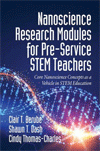
Nanoscience Research Modules for Pre-Service STEM Teachers
Core Nanoscience Concepts as a Vehicle in STEM Education
By:
Clair T. Berube, Hampton University
Shawn T. Dash, Hampton University
Cindy Thomas-Charles, Hampton University
Published 2019
STEM (science, technology, engineering and mathematics) is a fairly new concept in American education. As separate subjects, science and math have been around for a long time but have rarely been taught as a seamless unit of skills; rather as discreet content areas. This is not how the real world outside of the classroom functions however; in actual research laboratories scientists infuse their science with math, and their math with science, and along with technology and engineering they solve real life problems. In practice you cannot separate the various fields, as you need all of them in order to discover the underpinnings of the natural world, cure a disease, or solve a problem with the space rover. The American future depends on a scientifically literate workforce, armed with knowledge about the laws and theories of science, based on empirical facts instead of beliefs. In addition, there is a shortage of graduates in STEM related disciplines. Economic data show that 1 million additional STEM graduates will be needed over the next decade to fill America’s economic demand. STEM based jobs are expected to grow 17% in the next 10 years, outpacing the overall job growth of 10%. If teachers across America were trained with fundamental and impending scientific concepts in their science-methods courses at the university level, scientific literacy can only dramatically improve. Nanoscience is one such concept; as it is multidisciplinary in nature and is regarded as the basis for innovated technologies in many fields. The authors of this book seek to provide pre-service and in-service science teachers with high-quality STEM modules, with which to create lesson plans and problem-based lessons to use in their future classrooms, both at the elementary and secondary level. Nanoscience was chosen since its applications reaches across virtually every scientific field; from biology to physics and for that matter all STEM domains.
CONTENTS
Foreword. CHAPTER 1: What is Nanoscience? Need for STEM. Nanoscience: The Unifying Concept in STEM. Scope and Purpose. CHAPTER 2: The Background Study
Methodology. Phase 1. Phase 2 (Fall 2015) Problem Based Learning (PBL) as a Means to Teach Nanoscience to Pre-Service Teachers. Phase 1 Timeline and Date Management. CHAPTER 3: The Manual Nanoscience Manual. Phase 2. Nanoscience in the Classroom Introduction. Module 1: Metric Units and the Nanoscale. Module 2: Nanoscience and Technology. Module 3: Nanoproducts. Module 4: Silver Nanoparticles As an Antimicrobial? Module 5: Zinc Oxide, Producing Nanoparticles With an Experiment on Their Use Module. 6: Nano-Encapsulation. Module 7: Nanoscience in Nature: Build a Beetle. CHAPTER 4: In the Classroom Lesson Planning. Teaching to the Objective. References. About the Authors.
-
Paperback9781641135528
Web price: $45.04 (Reg. 52.99)
-
Hardcover9781641135535
Web price: $80.74 (Reg. 94.99)
- eBook9781641135542

- SCI063000 - SCIENCE: Study & Teaching
- EDU029030 - EDUCATION: TEACHING METHODS & MATERIALS: Science & Technology
-
 Continuous Improvement
A Leadership Process for School Improvement
Continuous Improvement
A Leadership Process for School Improvement
-
 Digital Technologies and Early Childhood in China
Policy and Practice
Digital Technologies and Early Childhood in China
Policy and Practice
-
 Mandy Hoffen and a Conspiracy to Resurrect Life and Social Justice in Science Curriculum with Henrietta Lacks
A Play
Mandy Hoffen and a Conspiracy to Resurrect Life and Social Justice in Science Curriculum with Henrietta Lacks
A Play
-
 Out-of-School-Time STEM Programs for Females
Implications for Research and Practice Volume II: Short-Term Programs
Out-of-School-Time STEM Programs for Females
Implications for Research and Practice Volume II: Short-Term Programs
-
 Teaching and Learning Online
Science for Elementary Grade Levels
Teaching and Learning Online
Science for Elementary Grade Levels
-
 Teaching and Learning Online
Science for Secondary Grade Levels
Teaching and Learning Online
Science for Secondary Grade Levels
-
 Unveiling the Cloak of Invisibility
Why Black Males are Absent in STEM Disciplines
Unveiling the Cloak of Invisibility
Why Black Males are Absent in STEM Disciplines

